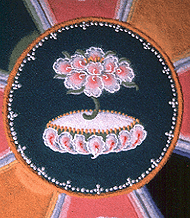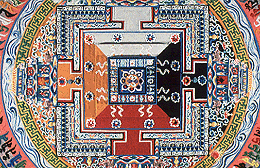Losang Samten

Photo courtesy of the artist
Bio
Born in Tibet in 1953, Losang Samten escaped in 1959 and settled in India. In 1975, while studying in the Namgyal Monastery, he was chosen to enter a three-and-a-half year intensive training program in sand mandala painting, the ritual art form that originated in India 2,500 years ago and that has been practiced in Tibet since 600 A.D. The sand mandala is an elaborate design based on instructions in ancient texts, and is usually done collaboratively as part of a religious ceremony or initiation. Accompanied by recitation of prayers, chanting, and occasionally ritual dance, brightly colored designs are created. Then, in keeping with the Buddhist principle of impermanence, the finished product is dismantled and poured into a body of water. In addition to having artistic skills, the monks and artists selected for this training must be able to memorize 500 pages of sacred text. Only four of the 28 monks in Mr. Losang's class finished the course in the three-year period. For centuries, sand mandala painting had not been seen outside of monasteries, but in 1988, the Dali Lama selected Losang to create a mandala in a museum setting in the West. In 1989, he moved to Philadelphia where he became Spiritual Director of the Tibetan Buddhist Center. Today, he continues to teach and to practice mandala painting as one of an estimated 30 people in the world who are qualified to teach and demonstrate this spiritual art form.

|

|
|
Interview with Mary K. Lee
NEA: I want to congratulate you on your award. Could you talk about your reaction when you heard the news?
MR. SAMTEN: I got the phone call from Barry Bergey and I didn't understand at first what the phone call was about. After he explained, I was really very happy. I truly care for this tradition and so the recognition is wonderful.
NEA: Can you tell me how you became a mandala painter?
MR. SAMTEN: In my monastery, the Namgyal Monastery - the monastery of His Holiness the Dali Lama - mandala painting is one of the subjects we have to learn. You have to learn the painting, the design, the meaning of the colors and the purpose.
I came to the United States in 1988 and since then there has been a huge interest across the country - and all over the world, in fact - from museums and galleries wanting to know about this culture, especially sand painting or sand mandala.
NEA: When you came in 1988, was that when you created mandala in the Museum of Natural History in New York City?
MR. SAMTEN: Yes. It was the first time I had never done that kind of project in a museum or for the general public. At the beginning we really didn't know how it would go, but from the museum and the public' s point of view it was very successful. There was lots of media interest, Time magazine and of course The New York Times. Since then a number of artists - not just me - have been traveling and doing the sand mandala publicly.
NEA: What is usually the hardest part of learning how to do the sand painting?
MR. SAMTEN: The hardest part is memorizing all the designs and the colors and which color goes where and which design does what. In our tradition, when you make the mandala you cannot look at a picture of it while you are doing it. You have to memorize the mandala first. Memorization is the hardest part, especially knowing the meaning of each color. Each color has many different levels of meaning.
NEA: Could you explain that a little further?
MR. SAMTEN: From the general point of view the white is the water, south is yellow, west is red, north is green and the center is blue. White represents water, yellow represents the earth, red represents fire, green represents the air and blue represents space.
Additionally the colors represent what we call five aggregates: bone, feeling, perception, formation, consciousness and the senses. The colors are also an antidote for the emotions anger, hatred, jealousy, attachment, ignorance. So there' s many different elements to the colors.
NEA: And how many different designs are there?
MR. SAMTEN: I would say countless mandala.
NEA: And how many would you say that most monks master when they' re going through the training?
MR. SAMTEN: There' s a mandala called the Wheel of Time, which is one of the most complex mandalas. If the artist has learned that design the rest of the training is much easier. In the Namgyal monastery five or six mandalas are emphasized. Once you' ve had that training then the rest of the mandalas are very easy to learn.
NEA: Is it correct that each mandala has a specific purpose?
MR. SAMTEN: Oh yes. For example, there' s a Mandala of Compassion to emphasize and cultivate loving kindness compassion. There' s the Mandala for Wisdom, the Mandala for Healing and the Mandala for Medicine. Each has a different theme. Which mandala we create in the monastery depends on what is being emphasized that month.
NEA: What about in a museum setting?
MR. SAMTEN: At a museum, since I'm often asked to do more in the public eye, I will usually design a Mandala of Compassion, a loving kindness mandala. In institutions like a university gallery, I will do a Mandala of Wisdom. Of course, I do show them many different designs that I could do. Often they will choose what they think is more interesting.
NEA: I read that you created one at Trinity College in Connecticut.
MR. SAMTEN: At Trinity College I did a Mandala of Compassion. What I didn't know at the time was that the college was going through a time of unease, something was going on that I was unaware of. The head of the college was going to resign, he had gotten another job or something like that. Apparently, the faculty and the students felt that for the six weeks it was there the mandala brought some kind of unity and harmony to the college. And so did the many local people who came to see it. So they were very appreciative of the mandala.
NEA: In the West, a work of art is usually an individual endeavor, whereas with the mandala there' s often collaboration with three or four artists. Also in the West, we save and display our art, there' s not the impermanence as with the mandala. Are people surprised by the fact that you don' t save the mandala and do they ask you questions about that?
MR. SAMTEN: Oh yes. Everywhere I do the mandala the first question is "Why not keep it? Why dismantle it?" If the mandala is small or if I'm in the middle of the design, it' s easier for them to accept this. But later on, when I've finished whole design and the piece is six, seven feet, when we are about to dismantle it, everybody' s shaking their heads.
But when we explain why it' s being dismantled and about the tradition and meaning of behind doing that, there' s a better understanding. A lot of ancient civilizations, a lot of traditions have the idea of creating something from nature for healing or meditation or some kind of call and then that energy is returned back to the earth, back to nature.
I'm finding more and more people appreciative of that tradition. But there are still a lot of people who don' t understand why - think it such a pity - that after so many days of working so hard we dismantle it. It is very difficult for them, which I understand. Many people come up to me and say, "Look, Losang, how nice this work is. you're an artist and the life of an artist not easy. You can sell this, you can make a lot of money here." People have different ideas.
NEA: I've read that you're also a spiritual leader here in the United States.
MR. SAMTEN: I don' t know that I'm a spiritual leader, but I do teach meditation classes. In the U.S., while people have lots of wonderful things, many are depressed and looking for different answers. There' s quite a bit of interest in spirituality and meditation. I don' t see myself as a spiritual leader or mentor. I'm just an ordinary artist. I studied a kind of Buddhist philosophy and meditation. I came here and am doing sand painting, but sometimes there' s a lot of interest in what I've learned from His Holiness the Dali Lama and some of the things I have heard or read. So I just go around and share some of the ideas which can bring people peace.
NEA: Do you go ever go back to India to teach?
Losang Santem: I go every year if I have enough money to pay the airfare. I listen to Dali Lama' s teachings and since several of my teachers are still alive, I go to see them for some meditation or spiritual retreat.
NEA: You were the personal assistant to the Dali Lama. Can you just say a few words about what that experience was like?
Losang Santem: That is a very personal thing. I dont talk that much about that.
NEA: I understand.
Losang Santem: I'm just an artist, you know. But, yes, I was had the privilege serving his Holiness.
NEA: And what are some of the biggest challenges you see to maintaining and practicing the sand painting?
Losang Santem: Traditionally the mandala is not just for display, but for our own spiritual practice. A person or an artist can get to a place where they can draw the design very well, but still have difficult to carrying the message in their minds. That might be the challenge for a lot of people here.
NEA: I understand you also make butter sculptures? Can you tell me a little bit about that?
MR. SAMTEN: The butter sculpture is merely a butter cake. It' s an offering to a Buddha or an offering to yourself or and offering to all living beings. Here we call it cake, but in Tibet we call it butter sculpture. We use yak butter which we dye with different food colors and then make a lot of different very elaborate designs in the butter sculpture. There are many different butter sculptures depending on the ceremony and the holiday.
NEA: The Smithsonian Folklife Festival presented Tibet a few years ago Were you involved in that?
MR. SAMTEN: I came to all the events. The Dali Lama was there and some of the monks from my monastery were there to do sand painting. I didn't do a special program myself but went to observe and to help some of the monks.
NEA: Can you tell me why you think sand painting is so valuable to the Tibetan community?
MR. SAMTEN: In the Tibetan culture it' s sometimes hard to distinguish Tibetan culture and some of the Buddhist message of loving kindness compassion. The mandala is really aiming for the symbol of generating loving kindness compassion. So that' s why people see our art as a being valuable.
NEA: I have one one final question. Could you talk what you're looking forward to when you come to Washington?
MR. SAMTEN: I'm really looking forward to meeting the rest of the artists who are coming. I'm looking forward to the program. I'm also going to do a small design and I'm looking forward to that.

